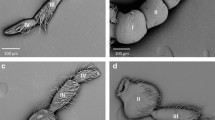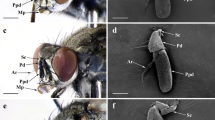Abstract
ANTENNAL receptors which mediate various stimuli are concentrated on three segments in higher Diptera1–3. The scanning electron microscope (Cambridge Stereoscan) has now disclosed previously undetected structures on the pedicel or second antennal segment of a number of common flies (Figs. 1a, b). (Specimens were gold coated at 200 Å and the microscope was operated at from 3 to 10 kV with an aperture of 200µ.)
This is a preview of subscription content, access via your institution
Access options
Subscribe to this journal
Receive 51 print issues and online access
$199.00 per year
only $3.90 per issue
Buy this article
- Purchase on Springer Link
- Instant access to full article PDF
Prices may be subject to local taxes which are calculated during checkout
Similar content being viewed by others
References
Slifer, E. H., Ann. Rev. Entomol., 15, 121 (1970).
Burkhardt, D., and Gewecke, M., Cold Spring Harbor Symp. Quant. Biol., 30, 601 (1965).
Schlegel, P., Z. Vergl. Physiol., 55, 278 (1967).
Author information
Authors and Affiliations
Rights and permissions
About this article
Cite this article
GREENBERG, B. Species Distribution of New Structures on Fly Antennae. Nature 228, 1338–1339 (1970). https://doi.org/10.1038/2281338a0
Received:
Revised:
Issue Date:
DOI: https://doi.org/10.1038/2281338a0
Comments
By submitting a comment you agree to abide by our Terms and Community Guidelines. If you find something abusive or that does not comply with our terms or guidelines please flag it as inappropriate.



